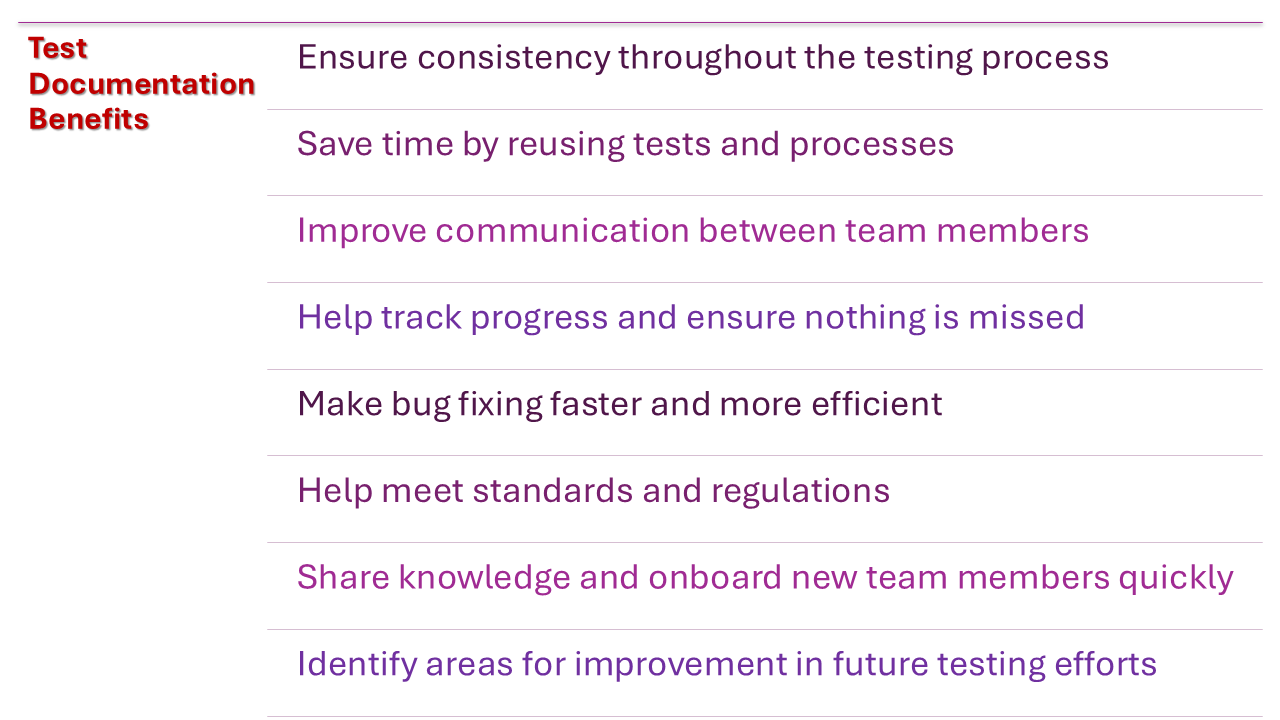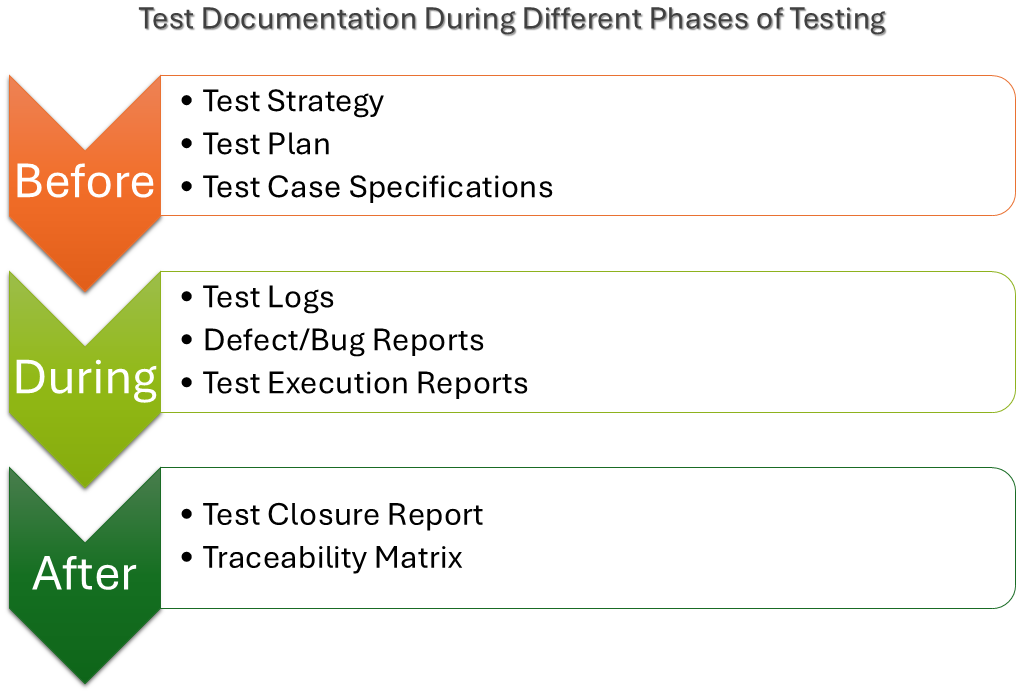Test Documentation: Best Practices with Examples
|
|
The act of documenting our actions is something we’ve been doing since we were little kids.
Remember your chemistry laboratory experiments back in school? You’d do some practical dabbling with chemicals. Whether your experiment was a success or not, there was one thing we all did – write down exactly what we did in the laboratory! Maybe even draw diagrams and label them or make flowcharts to record the process. The reasons for writing could be different – we wanted to remember the exact steps so that we could recreate it again during the final exams or just a requirement, to abide by the rules.
Test documentation is a similar concept, just that it’s for software testing-related activities.
Let’s learn more about test documentation and how to do it effectively.
What is Test Documentation?
Test documentation is the act of documenting different aspects of the testing process. It’s like a roadmap that make sure everyone involved in testing – whether developers, testers, or stakeholders – knows what’s being tested, how it’s being tested, and the results of those tests. These documents help to make sure testing is done systematically, efficiently, and transparently.
Test Documentation vs. Test Artifact
Quite often, these two terms are used interchangeably, although they differ a bit in intent. However, there is definitely an overlap between the two. Test documentation ensures you plan and track testing efficiently, while test artifacts are the products that show the testing is actually happening. Let’s look at them one at a time.
QA Documentation
It’s a collection of written materials that explains and organizes
- how testing will be carried out
- what needs to be tested
- how it will be tested
- and what results are expected.
It’s everything you write down to plan, organize, and communicate about testing before, during, and after the tests. In simpler terms, test documentation is the planning and tracking part of testing that makes sure everything is in place and runs smoothly.
QA Artifact
Test artifacts, on the other hand, are the actual products or outputs created during the testing process. These are the things you produce and use while carrying out tests, and they show the actual work of testing. You can think of test artifacts as “deliverables” that come from the testing activities. They are what you create and use to perform, document, and track tests.
Read more on this over here: Test Artifacts: Meaning, Types, and Best Practices.
Why Invest in Test Documentation?
“All good things come to those who wait.”
Remember this the next time you get bored with test documentation! While the process might be slow and lengthy, it has many long-term benefits.

Test Documentation Types and Examples
These different kinds of written records help organize and manage the testing process.
Test Strategy
- What it is: The test strategy is a high-level document that outlines how testing will be approached across the entire project or product. It’s like a roadmap for testing.
- What it covers:
- The general approach to testing (e.g., manual or automated).
- Types of testing to be performed (e.g., functional, performance, security).
- The tools and resources needed.
- The roles and responsibilities of the team.
- The test environment requirements (e.g., servers, databases).
- Why it’s important: It sets the overall direction for testing and ensures the team is on the same page from the beginning.
- Here’s an example of what a good test strategy looks like: Test Strategy Template
Test Plan
- What it is: The test plan is a more detailed document compared to the test strategy. It outlines exactly what will be tested, how it will be tested, and who will do the testing. It’s a project-specific document.
- What it covers:
- The scope of testing (which features or parts of the software will be tested).
- Testing objectives (what we aim to achieve with testing).
- The timeline (when the testing will happen).
- Resources required (tools, environments, team members).
- The entry and exit criteria (conditions that define when testing starts and ends).
- Risk analysis (potential problems that could affect testing).
- Why it’s important: It provides a detailed plan to ensure testing is thorough, organized, and aligned with project goals.
- Here’s an example of what a good test plan looks like: Test Plan Template
Test Case
- What it is: A test case is a set of detailed instructions that tells the tester exactly what to do to test a particular feature or functionality of the software. Think of it like a checklist for testers to follow.
- What it covers:
- Test Case ID: A unique identifier.
- Test Objective: What the test is trying to verify or validate.
- Preconditions: Any setup that needs to be done before executing the test.
- Test Steps: The actions the tester must follow to execute the test.
- Expected Results: What should happen when the test steps are followed correctly?
- Actual Results: What actually happened during the test?
- Pass/Fail Status: Whether the test passed or failed.
- Why it’s important: It helps ensure that tests are consistent, repeatable, and focused on specific parts of the software.
- Here’s a detailed look at writing good test cases: How to Write Test Cases?
Test Script
- What it is: A test script is an automated version of a test case. It is a piece of code written to automatically run a set of tests on the software without manual intervention.
- What it covers:
- Automated instructions to test a feature or function.
- Input data, actions to perform, and expected outcomes – all coded into the script.
- Why it’s important: It allows for faster testing, especially when tests need to be repeated multiple times, and is useful for regression testing.
- Here’s a detailed look at writing good test scripts: How to Write Effective Test Scripts?
Test Data
- What it is: Test data refers to the input information used during testing to simulate real-world scenarios and validate the behavior of the software.
- What it covers:
- Data sets that represent different scenarios (e.g., valid and invalid usernames, passwords, or product information).
- Why it’s important: Without proper test data, it’s impossible to verify if the software behaves correctly in different situations.
- Read more about how to generate good test data over here: Generating Good Test Data.
Test Log
- What it is: A test log is a detailed record of everything that happens during testing. It’s like a diary that keeps track of test executions.
- What it covers:
- Which tests were run.
- When they were executed.
- Who executed them.
- The results of each test (pass/fail).
- Any defects or issues that were found.
- Why it’s important: It helps track testing progress, troubleshoot issues, and gives insight into what happened during the test execution.
- Read more about this over here: What are Test Logs
Defect/Bug Report
- What it is: A defect or bug report is a document created when a problem or issue is found during testing. It captures all the details about the bug so the development team can fix it.
- What it covers:
- A description of the issue.
- Steps to reproduce the bug.
- The severity and priority of the bug.
- Any related screenshots, logs, or error messages.
- Why it’s important: It ensures that defects are properly documented and tracked so they can be addressed by the development team.
- Read more on this over here: Preparing Bug Reports
Traceability Matrix
- What it is: This document links test cases to requirements to make sure that all the software’s requirements are tested.
- What it covers:
- A table or grid that connects each requirement with the corresponding test cases.
- Why it’s important: It helps make sure that all parts of the software are tested and that no requirements are overlooked.
- Read about the traceability matrix over here: What is RTM?
Test Report
- What it is: It is a summary of the testing process that shows the results of the tests, including what was tested, what worked, and what didn’t.
- What it covers:
- Summary of tests executed.
- Pass/fail status of tests.
- Defects or issues found during testing.
- Test coverage and overall quality of the software.
- Why it’s important: It communicates the results of testing to stakeholders, which helps them make informed decisions about the software.
- Read more about this: Test Reports.
Test Closure Report
- What it is: The is a final document that summarizes the entire testing process once testing has been completed.
- What it covers:
- What was achieved during testing?
- What defects were found and whether they were resolved?
- Lessons learned during the testing process.
- Recommendations for future testing efforts.
- Why it’s important: It closes out the testing phase and provides insights that can improve future testing efforts.

Software Testing Documentation: Best Practices
Here are some tips to help you craft good test documentation.
Be Clear and Simple
The purpose of test documentation is to communicate, so it should be easy to understand for everyone involved, whether they are testers, developers, or managers.
How to do it:
- Use plain language and avoid jargon or technical terms unless necessary.
- Make your documents short and to the point. Include only the essential information.
- Use clear headings, bullet points, and tables to break down information into digestible chunks.
Be Consistent
Consistency makes your test documentation easier to read and follow, especially when multiple people are involved.
How to do it:
- Use consistent formatting for things like test case IDs, test steps, and result statuses (e.g., always use “Pass” or “Fail”).
- Follow standard templates for test cases, defect reports, and test plans so that all documents have a similar structure.
- Keep consistent terminology throughout your documents. For example, if you call a feature “Login Page” in one document, don’t refer to it as “Sign-in Page” in another.
Keep It Up to Date
Your test documentation should always reflect the current status of testing. For that to happen, you should regularly update it.
How to do it:
- Update test cases and logs whenever a change is made (e.g., a bug is fixed, or a test fails).
- Review test documentation at regular intervals, especially if the scope or requirements of the project change.
- Ensure that defect reports are updated as bugs are investigated and fixed.
Be Thorough, But Don’t Overload
Provide enough detail to ensure tests are repeatable and effective. But you need to make sure that you don’t make things too complicated.
How to do it:
- Describe test steps clearly: A good test case should have detailed, actionable steps without being overly complex.
- Focus on what’s important for the test. Don’t include unnecessary details that don’t directly affect the outcome.
- For defect reports, provide enough information (e.g., steps to reproduce the bug) to help developers fix the issue quickly.
Make Test Documentation Easy to Find
Test documentation should be well-organized so team members can find what they need quickly.
How to do it:
- Use a centralized location for storing test documentation, like a shared drive, document management system, or test management tool.
- Organize test documents in a logical order (e.g., group by feature, version, or release).
- Use clear file names so documents are easy to locate (e.g., “Test Plan v1.0,” “Defect Report – Login Bug”).
Include Traceability
Make sure your test cases are linked to the requirements they’re meant to validate. This shows that all requirements are being tested.
How to do it:
- Use a traceability matrix to map test cases to their corresponding requirements.
- In each test case, include information about which feature or user story it is testing.
- Ensure that every critical requirement has at least one corresponding test case.
Keep Track of Changes
As projects evolve, changes happen. Test documentation should reflect these changes so everyone is working from the same information.
How to do it:
- Version control: For major changes, create new versions of test plans, cases, and reports (e.g., “Test Plan v1.1”).
- Track updates: If a test case is modified, add a brief note about why it was changed (e.g., “Test case updated to reflect new login functionality”).
- Date changes: Always include the date of the last update for clarity.
Use Templates
Templates save time and ensure consistency across all documents.
How to do it:
- Create or use pre-existing templates for common documents like test cases, test plans, and defect reports.
- Use templates that include all the necessary fields (e.g., test case ID, description, steps, expected results).
- Customize templates based on the specific needs of your project, but make sure they cover the basics.
Conclusion
Test documentation can be a powerful ally when you’re stuck in situations where you don’t know what to do or need to prove that things happened a certain way. You can use different digital tools to document each of these items. Many overlook the value that test documentation holds because of the discipline and efforts needed to do it. But this very documentation can save you from some sticky situations like audits or customer complaints!
| Achieve More Than 90% Test Automation | |
| Step by Step Walkthroughs and Help | |
| 14 Day Free Trial, Cancel Anytime |












